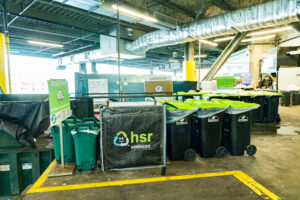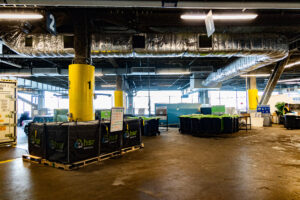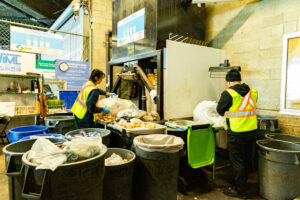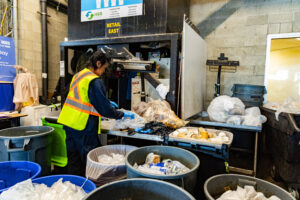Convention Center Zero Waste Transformation
Projects Sponsor
Faced with a mere 50% waste diversion rate and escalating costs, Vancouver Convention Centre (VCC) awarded Happy Stan’s Recycling Services (HSR) their resource management contract. HSR took full control of all waste streams while providing consulting services—including internal Zero Waste training to their sustainability team and event planners, event audits, and tenant tracking. HSR’s comprehensive program redesigned waste flows and reconfigured existing equipment and processes, all without disrupting operations. VCC now achieves 75-90% diversion monthly, diverting over 1 million kg in 2024 alone, proving zero waste is more than viable for major venues—it’s fundamental.
As one of the most recognized sustainable venues in Canada and the first double LEED Platinum-certified convention facility, the Vancouver Convention Centre (VCC) set a goal of improving their waste diversion performance. Stagnant at a disappointing ~50 percent, the centre’s waste diversion did not align with its environmental commitments. Changing that stat while accommodating the complexity and unpredictability of large-scale events presented a challenge. The shows, after all, had to go on.
 Additionally, VCC wanted to achieve this meaningful change without relying on new infrastructure or incurring capital costs and, while the budget was fixed, little else about running a convention center is. What was needed was a program flexible enough to handle wide fluctuations in both volume and waste composition, driven by highly variable event types and attendance. At the same time any new system would have to manage costs in a way that allowed for consistent service in the venue without creating excess capacity.
Additionally, VCC wanted to achieve this meaningful change without relying on new infrastructure or incurring capital costs and, while the budget was fixed, little else about running a convention center is. What was needed was a program flexible enough to handle wide fluctuations in both volume and waste composition, driven by highly variable event types and attendance. At the same time any new system would have to manage costs in a way that allowed for consistent service in the venue without creating excess capacity.
That was the challenge Happy Stan’s Recycling Services (HSR) accepted when the Vancouver Convention Centre awarded them their resource management contract. The project goal was to create a complete waste management system that would not only significantly increase diversion, but also be operationally efficient, scalable, and financially sustainable. The project aimed to make environmental performance a practical and achievable outcome in a high-traffic, real-world setting. It also set out to demonstrate that zero waste can be implemented, at scale, without costly investment or disruption to ongoing operations.
HSR had their work cut out for them and that work began with homework. Before launching the project, the HSR team conducted a detailed assessment of the VCC’s existing waste system, focusing on equipment availability, waste composition, and cost structure and this review led to several interesting findings.
Firstly, the site consisted of two connected buildings with multiple compactors, offering some built-in redundancy. The team saw an opportunity to reallocate equipment rather than invest in new infrastructure. A waste composition analysis revealed that post-sorting, only 10 to 15 percent of total material would remain as residual waste. Of the recyclables previously going into a mixed compactor, over 80 percent was corrugated cardboard and only 20 percent was mixed containers.
Managing all recyclables together in one compactor was projected to cost over $300 per metric ton due to downstream labour cost escalations. However, separating cardboard, it was calculated, could instead generate a return of $30 to $60 per metric ton. This was clearly a potential reduce, reuse, recycle, realize gains situation.
 The HSR team forecasted that this shift could reduce total waste volumes by up to 80 percent. This would allow them to consolidate landfill-bound waste into one compactor, reassign another compactor to cardboard, and dedicate a third to mixed containers.
The HSR team forecasted that this shift could reduce total waste volumes by up to 80 percent. This would allow them to consolidate landfill-bound waste into one compactor, reassign another compactor to cardboard, and dedicate a third to mixed containers.
Implementing a hands-on in-house sorting program by integrating trained sorters into the housekeeping workflow, staff were positioned in a designated sorting area to manually separate cardboard, containers, and organics before any materials entered the compactors. Early pilot runs allowed them to refine staffing levels for different event sizes and of course other adjustments had to be made. A structured list of questions to collect better information from event organizers was developed and a reference database was established to help forecast needs more accurately.
After rollout, the team noticed weights in the compactors were higher than expected. A follow-up visit to the transfer station revealed two key issues: excess liquids from cleaning operations and unauthorized vendor dumping. Installing compactor locks, controlling access through designated staff only, and working with building management to divert liquid waste to the black water system significantly reduced contamination and improved load quality.
Additionally, it was discovered that during busy events, internal teams lacked enough bins to service the venue, and sorting teams lacked storage space. This issue was solved by the purchase of secondary equipment that could be deployed on-demand, ensuring both internal operations and sorting teams were adequately supported.
 These various obstacles and missteps were essential to refining the system. By addressing them head-on and adapting quickly helped refine a model that others can now adopt more efficiently and with fewer setbacks.
These various obstacles and missteps were essential to refining the system. By addressing them head-on and adapting quickly helped refine a model that others can now adopt more efficiently and with fewer setbacks.
With materials now properly separated, the HSR team was indeed able to shift 80 percent of recycling volume from high-cost mixed streams to valuable cardboard rebates—racking in cash instead of taking out trash. These changes improved operational efficiency and helped offset the labour costs associated with manual sorting. Further research revealed other opportunities for diverting other bulky material that was making up a large portion of the waste stream. Regular outlets were found for more disposed of items, including carpet tiles, hay bales, sand and gravel, plywood, banner displays and other durable items that were in usable condition.
Once the new processes had stabilized, a weight tracking program was developed with reported data sent to the Convention Centre over a three-month period to help them assess how to recoup costs. The HSR team measured the volume of unsorted waste generated by each retail tenant and produced regular reports for the Convention Centre’s management. This data enabled targeted discussions on cost recovery and helped fine tune staffing and equipment deployment for future events, calculations that are ongoing, fostering continuous improvement.
 Working collaboratively with both venue staff and event organizers through each of these stages: assessment, equipment reallocation, team integration, contamination control, cost recovery, and data reporting made it possible to implement a highly replicable program that significantly improved diversion to 75 to 90 percent on a monthly basis. And, yes, this was achieved without any capital infrastructure costs—thus advancing the Vancouver Convention Centre’s sustainability outcomes and stabilizing their long-term operational costs.
Working collaboratively with both venue staff and event organizers through each of these stages: assessment, equipment reallocation, team integration, contamination control, cost recovery, and data reporting made it possible to implement a highly replicable program that significantly improved diversion to 75 to 90 percent on a monthly basis. And, yes, this was achieved without any capital infrastructure costs—thus advancing the Vancouver Convention Centre’s sustainability outcomes and stabilizing their long-term operational costs.
To date, 550 events and 1.8 million visitors later, over 1 million kilograms of material has been diverted from landfill and incineration. HSR has helped support VCC’s already strong position as an environmental leader in the convention industry. The improved waste diversion rates have become another tool VCC can highlight when working with sustainability-focused event organizers, a growing market.
Most significantly, this project demonstrates that with the right program and structure, venues of any size and complexity can achieve significant improvements in waste diversion. When venues, waste management partners, and stakeholders work together with shared commitment, meaningful environmental progress is achievable while maintaining excellent venue operations that bears, and invites, repeating.













